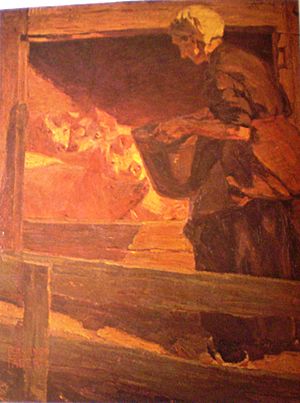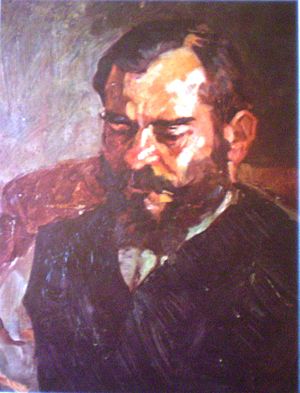Fernando Fader facts for kids
Fernando Fader (born April 11, 1882 – died February 25, 1935) was an important painter from Argentina. He was born in France. He painted in a style called Post-impressionism, which came after Impressionism.
Contents
Fernando Fader's Life and Art
Fernando Fader was born in Bordeaux, France, in 1882. When he was two years old, his family moved to Argentina. They lived in Mendoza, a city in the west. A few years later, they moved back to France.
After finishing high school, Fader returned to Mendoza in 1898. Here, he started painting city scenes. In 1900, he moved to Munich, Germany, to study art. He joined the famous Munich Academy of Fine Arts. There, he learned from Heinrich von Zügel, a well-known Naturalist artist.
Early Exhibitions and Challenges
Fader came back to Buenos Aires, Argentina, in 1906. His paintings were shown for the first time at the Costa Salon. His landscape paintings quickly showed him as a Post-impressionist artist. However, many art critics in Argentina at that time still preferred Impressionism.
Because of this, Fader joined other artists who were also not favored by the traditional Argentine art world. These artists included Cesáreo Bernaldo de Quirós, the sculptor Rogelio Yrurtia, and Martín Malharro. Their group, called Nexus, faced difficulties until about 1910.
Success and Health Issues
In 1914, Fader settled in Buenos Aires. He won a top prize at the Fourth National Art Bienale. He also visited art galleries in Spain and Germany. In 1915, he won a gold medal at the Pacific International Exposition in San Francisco, USA.
However, Fader soon became sick with tuberculosis, a lung disease. This forced him to move to a drier climate in the foothills of the Andes mountains in Argentina. He settled in Córdoba.
Painting in Córdoba
His time in Córdoba changed his painting style. He started using more Impressionistic techniques, focusing on strong sunlight and shadows. His new surroundings also gave him lots of ideas from farm life. During this time, he created many of his most famous works. These paintings often showed farm scenes in a romantic way.
Sadly, this productive period ended around 1921. Fader's breathing problems got much worse. He developed chronic asthma, which made it impossible for him to paint outdoors.
Later Years and Legacy
Even though he was forced to stay indoors due to his health, Fader remained popular. The National Academy of Fine Arts held a special show of his work in 1924. In 1932, art galleries in Buenos Aires organized another show with 119 of his paintings. This was to celebrate his 50th birthday, but he was too sick to attend.
Fernando Fader passed away in Ischilín Department, Córdoba, in 1935, at the age of 52. His old home in the small village of Loza Corral is now a museum.
See also
 In Spanish: Fernando Fader para niños
In Spanish: Fernando Fader para niños




